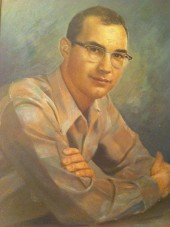 October 23, 2010.
October 23, 2010.
Dear Larry Criscione:
I am happy, even gay, to hear from you and that you are working to save that material. That you say some was harmed in the storm is an example of what we have worried about all these years—as there have been at least a dozen (not all lgbt) archives harmed by weather, fire, etc., or just general falling apart.
And your work is an example of why most of our lgbt archives and libraries have little time to communicate with each other. We are working with the few volunteers we have.
In the discussion with other people, including those in Houston, we have for years tried to decide what the best answer is to how to preserve and use the material we have that documents this civil rights movement, which since it only started in 1950 makes it easier than those of the women’s or black Americans’.
We at ONE/HIC, before the separation and after, were at first a magazine and educational organization but knew that, while we were making history, the library would be valuable long after we were gone. And we hoped that other people and groups would join the work, which history shows they have done more than could have been dreamed.
We knew the best way forward would be to maintain control of our material, but that needed an endowment which we never got. There was a tax-exempt part formed (ISHR), but its money was, sadly, wasted over legal fighting.
After the deaths of the three main people at ONE in the mid 1990s (Dorr Legg, Don Slater, and Jim Kepner), there was an effort made to rejoin all the material that had been saved by the then three separate parts of the original ONE. After ONE, Inc., was merged into ISHR, upon the death of Legg in 1994, the directors of ISHR donated the ONE Institute collection to USC, where it joined Jim Kepner’s International Gay and Lesbian Archives. The combined ONE/IGLA archives still exist as the ONE Archives—which this month were donated to the USC Library.
We at the HIC, under leadership of Dale Jennings and Jim Schneider, tried to rejoin but again had disagreements and have now placed our archival material on permanent loan within the Vern and Bonnie Bullough Collection on Sex and Gender, curated at CSUN, where it is safe—the library was rebuilt after an earthquake.
Another example of a collection that chose the same answer is the Tretter Collection at the University of Minnesota—which is hosting an exhibit of the collection this November, thus showing that one fear we had did not happen—that a library would not want to use the material.
Others have been able to get space from local lgbt centers—such as Philadelphia’s William Way, or have separate housing, such as in Chicago’s Gerber/Hart, Fort Lauderdale’s Stonewall, or Quatrefoil in Minneapolis/St Paul. Few own their own building—obviously needing much income—such as the Lesbian Herstory Archives in New York.
So we chose the middle way: the material is housed at a university, but we have some control and keep adding and can host events, etc.
The obvious problem (you know well) is that we still need community/movement support from the local lgbt media and organizations to not only donate their material but urge support of their members. Young people have to learn why our history is important. That is why we need to reach lgbt organizations at the universities. It is interesting that people will not donate to a library if they have to give through a church. I would think MCC needs an archive itself.
Your work is important and is not done by any other part of our community/movement. Supporting our work is no competition to the work of their groups, such as legal, religious, social service, etc. We need to get people to understand this. I hope that college students will learn and join the work. And people can give time when they retire. So I think we will just have to work in the meantime.
Best wishes, and I hope we can keep exchanging ideas and news.

